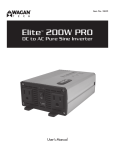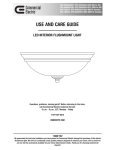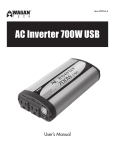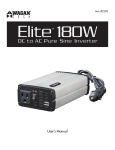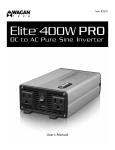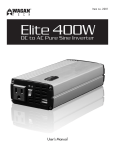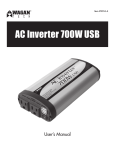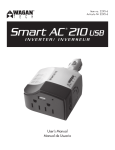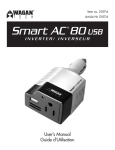Download Wagan 2005-1 User`s manual
Transcript
1,000 1,250 1,500 2,000 Watt: Watt: Watt: Watt: Item Item Item Item / / / / Artículo#2294 Artículo#2005-1 Artículo#2004 Artículo#2482 Slim Line Power Inverters ™ User’s Manual Manual de Usuario Slim Line™ Power Inverters by Wagan Tech® INTRODUCTION Thank you for purchasing a Wagan Tech ® Slim Line™ Power Inverter. With minimal care and proper treatment, it will provide years of reliable service. This User’s Manual describes the Operation, System Planning, Installation and Maintenance of four Slim Line Power Inverters. These are: 1,000W: #2294, 1,250W: #2005-1, 1,500W: #2004 and 2,000W: #2482. These four inverters are similar except for AC wattage output, DC input current, dimensions, and weight. Your Slim Line power inverter converts 12 volt battery power into 115 volts of AC power. You can use the inverter in your vehicle to operate many types of appliances that use AC power such as TV, DVD player, laptop computer, power tools, and lights for emergency or camping use. In an industry where the actual wattage output varies so greatly, Wagan Tech is proud to introduce TrueRated Power™ technology. All our inverters feature TrueRated Power. That simply means power tested and rated at a period of 24 hours continuous usage under full load. Many competing products claim “continuous duty”, when they are often only 20 minutes of “continuous” duty at full output. We also build our inverters with High Peak Surge rating to support motorized appliance start up. Read and understand this manual before installing and operating this inverter. Keep this manual for future use. 1 www.wagan.com User’s Manual—Read before using this equipment Features • Two LED indicators display the operating status of the inverter. • Multiple AC outlets allow for more than one appliance to be powered at the same time. • Mounting holes allow for safe stable installation. • High Peak Power: Allows you to power appliances that require large initial start-up wattage. • Low Battery Alarm: The inverter sounds an audible alarm then turns itself off if the battery becomes too low. • Auto Shutdown/Reset Protection: The inverter temporarily shuts itself down to protect itself from overheating. • Overload/Short Circuit Protection: The inverter automatically turns itself off if the connected load is too large or if it shorts. WARNINGS • Do not attempt to open the inverter enclosure. High voltage inside the unit is the same type of power as your electrical outlets at home. • Do not operate the inverter in or around water. The voltage of the unit makes it an electrical shock hazard if operated in wet conditions. Do not let any plugged in appliance’s cord get wet. • Do not connect the AC inverter directly to another AC power source. • Keep it away from children: The inverter produces power just like AC wall outlets at home and it should be treated seriously. CAUTIONS • Do not use the inverter in a positively grounded vehicle. • Allow at least 2 inches of clearance around the inverter for air flow. • If you operate the inverter in a moving vehicle, you need to secure the inverter to prevent it from shifting around while the vehicle is moving. • If there is anything wrong with the inverter, disconnect all power. • The following operations will damage and void the warranty of the inverter: ∗∗ Reversing polarity by connecting DC cables to incorrect terminals. ∗∗ Connecting the inverter to a power source greater than 15V DC. ©2012 Wagan Corporation. All Rights Reserved. Wagan Tech and wagan.com are trademarks used by Wagan Corporation. 2 Slim Line™ Power Inverters by Wagan Tech® FRONT PANEL All four inverters described in this manual have an ON/OFF rocker switch, two LED indicators, and multiple AC outlets. Actual locations of these components vary by model. Multiple AC outlets enable multiple appliances to be operated at one time. Below is a diagram of a typical front panel. Vents Power On Indicator (green) AC OUTPUTS POWER OVERLOAD Overload Indicator (red) ON On/Off Power Switch AC Outlets ON/OFF Switch – Controls operation of the inverter. The below indicators operate when the switch is ON. Green LED – When lit, indicates the inverter is on and operating normally. AC is present at the outlets. Red LED – When lit, indicates the inverter has shut down for any of the following reasons: 1. Low DC battery voltage – less than 10 volts. Preceded by an audible alarm. Charge the battery as soon as possible. 2. High battery voltage – greater than 15 volts. A rare condition. 3. Over temperature − Shut off the inverter and let it cool before restarting. 4. Overload – reduce the AC appliance load. Audible Alarm (not shown) – when it sounds, it indicates that the battery voltage is getting low and the inverter is about to shut down. If you can reduce the AC load, you can temporarily extend operating time. Charge the battery as soon as possible. 3 www.wagan.com User’s Manual—Read before using this equipment REAR PANEL All four inverters described in this manual all have two terminals for connecting battery cables. One terminal is the Positive (+) terminal [red]; the other is the Negative (−) terminal [black]. The Positive battery cable should have a Battery Protection Fuse installed within one foot of the battery connection. The negative cable can be directly attached to the negative battery terminal. In some cases, a metal vehicle frame can be used as part of the negative cable to the battery. Cooling Fan Vents Cooling Fans (internally) Negative Terminal (black) Positive Terminal (red) High Speed Fan – Keeps the inverter circuitry cool. The fan operates when the inverter is powered on. To avoid unnecessarily draining of the battery, turn off the inverter when it is not in use. ©2012 Wagan Corporation. All Rights Reserved. Wagan Tech and wagan.com are trademarks used by Wagan Corporation. 4 Slim Line™ Power Inverters by Wagan Tech® MEASURING THE AC VOLTAGE This inverter’s AC output is a modified sine wave (MSW) 115 volts AC. Your household AC output is pure sine wave. The comparison of modified sine wave and household AC is shown in the figure below. (Puresinewave) This modified sine wave has a root mean square (RMS) voltage of 115 volts. Most ordinary AC voltmeters are calibrated to read “average” voltage and assume that the AC waveform will be a pure sine wave. These meters will not correctly read MSW voltage, and will display about 20 to 30 volts too low. Any multi-meter identified as “TRUE RMS” will accurately read MSW correctly. Product USAGE FUse 5 www.wagan.com User’s Manual—Read before using this equipment BASIC OPER ATION • Turn ON the power switch that is located at the front of the inverter, and the green LED indicator will light up as an indicator that the unit is working. • Plug your appliance(s) into the AC socket(s) at the front of the inverter. Pl anning the Inverter System Any large wattage inverter system requires planning before installation. There are several steps to the planning process so the user must determine the following: • Maximum inverter wattage required. • Operating time (run time) needed between battery recharges. • Battery bank capacity in amp-hours. • Charger requirement to charge batteries within a practical time. • Distance between battery bank and inverter. DETERMINING M A XIMUM APPLIANCE WAT TAGE Maximum AC Appliance Wattage is the first factor in planning battery and charging systems. Some background: Large microwave oven specifications list cooking power (watts) and appliance power. Appliance power is the AC load the inverter has to supply. Most other electrical tools, appliances and audio/video equipment have labels that list the unit's power requirements in watts. If the tool or device is rated in amps, multiply the amps by 115 (115V AC) to determine the watts. For example, a power tool rated at 4-amps will draw 460 watts. Most electrical tools, appliances, and audio/video equipment have labels that list the unit’s power requirements in watts. For example, large microwave oven specifications will list cooking power (watts) and appliance power (the AC load the inverter has to supply). If the tool or device is rated in amps, multiply the amps by 115 (115 volt AC) to determine the watts. For example, a power tool rated at 4 amps will draw 460 watts. Determine the wattage of each appliance you need to simultaneously operate. Add all of the appliance wattages to obtain an estimated “total watts” number. Remember to consider the start-up surge that motorized appliances will cause. ©2012 Wagan Corporation. All Rights Reserved. Wagan Tech and wagan.com are trademarks used by Wagan Corporation. 6 Slim Line™ Power Inverters by Wagan Tech® Do not exceed the surge rating of this inverter. This can cause immediate overload shut down. At maximum continuous output, this inverter requires a DC power supply (battery bank) that can continuously supply required amps at 12V DC for the duration of the run time. CONFIGURING THE BAT TERY BANK To determine the minimum battery ampere-hour rating that you will need to operate appliances from the inverter, and any DC appliances powered by the battery bank, follow these steps: 1. List the maximum continuous wattage that the inverter has to supply. 2. Estimate the number of hours the appliances will be in use between battery recharges. This will vary depending on appliances. For example, a typical home-use coffee maker draws 500 watts during its brew time of 5 minutes, but it only requires 100 watts thereafter to maintain the temperature of the pot. Similarly, a typical use of a microwave oven is only for a few minutes. Some longer operating time appliances are lamps, TV’s, computers, and refrigerator/freezers. 3. Determine the total watt-hours of energy needed. This is done by multiplying average power consumption in watts by hours of run time. For example: 1,000 watts for 10 hours = 10,000 watt hours. To get an estimate of the maximum current (in amps) that a battery bank must be capable of delivering to the inverter, divide the load watts by 10. For example a 1,000 watt appliance load will need 100 amps at 12 Volts DC. Using the 1,000 watts (or 150 Amps) for 10 hours example as above, then 100 amps is needed for 10 hours. This provides us with the basic amp-hours (AH) of battery that is required. Ten hours at 100 amps equals 1,000 Amp Hours (AH). This answer is just a beginning of configuring the battery bank because there are additional factors that determine actual run time. These include: • AC appliance load and time in use (basic AH) • Cable gage and length (cable losses) 7 www.wagan.com User’s Manual—Read before using this equipment • Charge level of the batteries (between use, chargers have to be able to fully charge the batteries) • Temperature of the batteries (colder batteries provide fewer amps) • Age and condition of the batteries (older batteries lose AH capacity) • Compliance with turning off unnecessary AC loads • Use of DC appliances and compliance with turning off unnecessary DC loads • If the inverter is installed in a vehicle and the alternator output in Amps cannot supply enough current for the inverter, additional batteries are required to supply the required current. DERATING THE BAT TERY BANK Most lead-acid batteries have a rating expressed in amp-hours (AH). The most common rating of AH is at the “20-hour rate”. NOTE: Despite several Internet explanations, here is no relationship between Cold Cranking Amps (CCA) and Ampere Hours (AH). For example, if a 20Ah battery is discharged at an 1 amp rate, is will take 20 hours to discharge that battery. The terms “charged” and “discharged” relate to actual battery voltage. This means that the output voltage of a nominal 12 volt battery starts at 13.2 volts (fully charged) then drops to 10.6 volts (discharged). If the load on the battery causes the battery to discharge faster than the 20 hour rate, the capacity (AH) of the battery is measurably reduced (derated). Derating is a major run time factor. Some benchmarks are as follows: • If an 100 Ah Battery is discharged at 100 Amps, the battery capacity acts like a 56 Ah battery. • If an 100 Ah Battery is discharged at 200 Amps, the battery capacity acts like a 32 Ah battery. Again, both high discharge rates are faster than the 20-hour rate so battery capacity seems lower. ©2012 Wagan Corporation. All Rights Reserved. Wagan Tech and wagan.com are trademarks used by Wagan Corporation. 8 Slim Line™ Power Inverters by Wagan Tech® INSTALL ATION Safe installation requires that a Battery Protection fuse is installed within one foot of the positive (+) battery Terminal [red]. Use ANL marine fuses or equal because they do not spark when they blow. Use an appropriate fuse holder for the fuse. ANL fuse holders can be mounted so they do not move in a vehicle or vessel. CONNECTING THE INVERTER Loose DC (battery) connections will result in a severe voltage drop that can cause damage to connectors, conductors, and insulation and can cause sparking. Reverse polarity connection can permanently damage to the inverter. Damage caused by reverse polarity will void the warranty. WARNING: Venting batteries produce explosive, corrosive gases. There is danger of explosion. DO NOT connect or disconnect BATTERY cables directly after battery discharge or recharge. Make sure that the battery bank area is well vented before attaching or removing cables. NOTES: All recommended cable gauges and fuse sizes are located at the rear of this manual in the Cable Gauge Table. The table describes Cable Gauges for lengths greater than supplied cables. “Round Trip” refers to actual cable distance in feet from the POS (+) battery terminal through the inverter and back to the NEG (−) battery terminal. Crimp-on ring terminals are required on all cable ends. The cable ends need to be stripped of insulation for 1/2 inch before crimping on ring terminals. Select a crimp terminal size to fit the cable gauge and inverter and battery terminal connectors. After crimping, make sure that the cable connectors are secure on the cables so there are no loose connections. CAUTION: Making an initial connection between the positive cable end and the inverter’s positive terminal may cause a spark. This is normal and is a result of capacitors in the inverter starting to charge. Because of the possibility of sparking, it is extremely important that both the inverter and the battery bank be positioned away from any source of flammable fumes or gases. Failure to heed this warning can result in fire or explosion. Do not make the positive terminal connection immediately after the batteries have been charging. Allow time for the battery gasses to vent to outside air. 9 www.wagan.com User’s Manual—Read before using this equipment Installation Procedure 1. Mount the inverter in a secure location. If the inverter is to be mounted on a wall, mount it horizontally. Make sure that the front and rear of the inverter has free air flow. 2. Make sure the cables are the proper gauge and have the fuse holder as close to the battery bank’s Positive (+) terminal as possible. 3. Install the fuse in the Positive (+) cable (Refer to the Cable Gauge Table at rear of manual). 4. Make sure the ON/OFF switch located on the front panel of the inverter is in the OFF (O) position. 5. Connect the Negative (−) cable end to the inverter terminal and battery Negative Terminal. Make sure you have good, secure connections. 6. Recheck and make sure the DC cable fuse is installed in the fuse holder. 7. Attach the positive cable to the Positive (+) DC connector on the battery and then the inverter. Make sure the connections are tight and secure. 8. Turn on the inverter from the Front Panel ON/OFF Switch. 9. Make certain that the green Operating LED is lit and the red FAULT LED indicator is not lit. 10.Turn OFF (O) the inverter. The Fault LED may briefly flash; this is normal. The audible alarm may also sound a short chirp; this is also normal. 11. When you have confirmed that the appliance to be operated is turned off, plug the appliance into one of the AC outlets on the front panel of the inverter. 12.Turn the inverter on. 13.Turn the appliance on. The appliance should begin working. 14.Observe the LED indicators for normal operation. If flooded lead acid batteries are used, be sure that periodic checks of battery electrolyte levels are accomplished. Follow battery manufacturer’s instructions in keeping the electrolytes at the proper level. Be sure to use pure distilled water when replacing evaporated electrolyte liquid. ©2012 Wagan Corporation. All Rights Reserved. Wagan Tech and wagan.com are trademarks used by Wagan Corporation. 10 Slim Line™ Power Inverters by Wagan Tech® RECOMMENDATIONS • If the power inverter makes a beeping sound, turn OFF the inverter, disconnect all appliances from the inverter and disconnect the inverter from the power supply. The beeping sound is the low battery warning that indicates that the voltage of the battery power supply is getting low. Please restart the vehicle engine to charge the battery before using it to operate the inverter again. • When you are not using the inverter, turn the power switch to OFF. This conserves battery power. OPER ATING tips Adding an Extension Cord If you need an extension cord, we recommend the use of an extension cord between the AC output of the inverter and the AC appliances. You may use up to 100 feet of high quality, heavy-duty extension cord. A longer cord will result in reduced power to appliances. Buzz in Audio Systems Some stereo systems and boom boxes will emit a buzzing noise from their loudspeakers when operated from the power inverter because the power supply in the device does not adequately filter the modified sine wave produced by the power inverter. The only solution is to use a sound system that incorporates a higher quality power supply. Television Interference Operating the power inverter can interfere with television reception on some channels. If this situation occurs, the following steps may help to alleviate the problem: • Do not operate high power loads with the power inverter while watching television. • Make sure the antenna feeding your television provides an adequate staticfree signal and you are using good quality cable between the antenna and the television. • Move the television as far away from the power inverter as possible. 11 www.wagan.com User’s Manual—Read before using this equipment • Keep the cables between the battery and the power inverter as short as possible and twist them together with about 2 to 3 twists per foot. This minimizes radiated interference from the cables. • Ferrite beads may be installed around battery cables and AC appliance cords to reduce noise. MAINTENANCE Very little maintenance is required to keep the inverter operating properly. Periodically check to ensure all terminals and connectors are secure and tight. HEAT DISPERSAL The inverter generates heat while it is working. This is not a malfunction. However, if the inverter gets too hot while working, it will turn off by itself. Position the inverter where air flows freely around it to allow the heat to disperse. The inverter’s thermal protection prevents it from operating when its temperature exceeds 130ºF ± 10ºF (55ºC ± 5ºC). TROUBLESHOOTING PROBLEM: Low or No Output Voltage – Fault LED Lit Reason Solution Poor contact with battery or inverter terminals. Clean terminals thoroughly. Reinstall and tighten. PROBLEM: Inverter Automatically Shut Down – Fault LED Lit Reason Solution Battery voltage below 10 Volts Charge or replace battery. Inverter is too hot. (Thermal protection mode.) Allow inverter to cool. Check for adequate ventilation. Reduce the load on the inverter to rated continuous power output. Unit may be defective. See warranty and call customer service. ©2012 Wagan Corporation. All Rights Reserved. Wagan Tech and wagan.com are trademarks used by Wagan Corporation. 12 Slim Line™ Power Inverters by Wagan Tech® PROBLEM: Inverter Automatically Shut Down – Fault LED Lit – OVL Display Reason Solution Equipment being operated draws too much power. Use a higher capacity inverter or do not use this equipment. PROBLEM: Continuous Buzzing Sound – Display Shows Low Voltage Reason Solution Input voltage below 10.5 Volts . Keep input voltage above 10.5 Volts Poor or weak battery condition. Recharge or replace battery. Poor or loose cable connection. Inspect terminals and tighten all connections. Inadequate power being delivered to the inverter or excessive voltage drop. Use heavier gauge DC cable. Keep cable length as short as possible. Disposal/Recycling of Inverter Electronic products are known to contain materials that are toxic if improperly disposed. Contact local authorities for disposal and recycling information. SPECIFICATIONS All specifications are typical at nominal line, half load and 77ºF (25ºC) unless otherwise noted. Specifications are subject to change without notice. 13 Name Description Input 12V (10V–15V) DC Output 115V AC Output frequency 60 Hz Output waveform Modified Sine Waveform www.wagan.com User’s Manual—Read before using this equipment Name Description TrueRated Power (24-hour continuous) #2294: 1,000 Watts #2005-1: 1,250 Watts #2004: 1,500 Watts #2482: 2,000 Watts Surge Power #2294: 2,500 Watts #2005-1: 3,050 Watts #2004: 3,500 Watts #2482: 4,000 Watts Efficiency Approximately 90% ™ No load current < 0.95 Amps Battery low alarm 10.5V ± 0.5V DC Battery low shutdown 10.0V ± 0.5V DC Alarm and thermal shutdown 130ºF ± 10º (55ºC ± 5º) Internal DC fuse 40 Amps External DC fuse None AC Outlets #2294: 3 #2005-1: 3 #2004: 3 #2482: 2 Power switch DC input ON/OFF control Dimensions (L x W x H) inches #2294: 10.3 x 5.4 x 2.5 #2005-1: 10.3 x 5.4 x 2.5 #2004: 12.3 x 5.4 x 2.1 #2482: 12.3 x 6.5 x 3.0 Gross Weight #2294: 3.5 lb #2005-1: 4.1 lb #2004: 4.1 lb #2482: 5.2 lb Net Weight (includes cables) #2294: 4.6 lb #2005-1: 5.4 lb #2004: 5.4 lb #2482: 6.9 lb ©2012 Wagan Corporation. All Rights Reserved. Wagan Tech and wagan.com are trademarks used by Wagan Corporation. 14 Slim Line™ Power Inverters by Wagan Tech® CABLE GAUGES BASED ON ROUND TRIP CABLE LENGTHS Models (Item#) Total Cable Length In Feet 1,000 W (#2294) 1250 W (#2005-1) 1500 W (#2004) 2000 W (#2482) 8 ft 6 4 4 2 9 – 10 ft 4 4 2 2 11 – 14 ft 2 2 2 0 15 – 17 ft 2 2 0 0 18 – 21 ft 2 0 0 00 22 ft 0 0 0 000 23 – 25 ft 0 0 00 000 120 200 200 250 FUSE AMPS* *User supplied battery protection fuse 15 www.wagan.com WAGAN Corp. Limited Warranty The WAGAN Corp warranty is limited to products sold only in the United States. All Wagan Tech products must be registered within (30) days of purchase to activate its warranty. To register your product, please visit http://tinyurl.com/waganwarranty. Be sure to keep the original receipt as it will be required when returning a product under the warranty. Warranty Duration: This product is warranted to the original purchaser for a period of one (1) Year from the original purchase date, to be free of defects in material and workmanship. WAGAN Corporation disclaims any liability for consequential damages. In no event will WAGAN Corporation be responsible for any amount of damages beyond the amount paid for the product at retail. Warranty Performance: During the above one (1) Year warranty period, a product with a defect will be replaced with a comparable model when the product is returned to WAGAN Corporation with an original store receipt. The replacement product will be in warranty for the balance of the original one (1) Year warranty period. To return a defective item, please contact WAGAN Corporation at (800) 2315806 to obtain a Returned Merchandise Authorization number (RMA#), and return instructions. Each item returned will require a separate RMA#. After you have received the RMA# and the return instructions from WAGAN Corporation, please follow the instructions and send the item with PREPAID SHIPPING, along with all of the required documentation, a complete explanation of the problem, your name, address and daytime phone number. WAGAN Corporation will, at its option, replace or repair the defective part. A Returned Merchandise Authorization number (RMA#) is REQUIRED when sending in any defective item. WAGAN Corporation is not responsible for any item(s) returned without an official Returned Merchandise Authorization number. The item(s) must be returned with prepaid shipping. WAGAN Corporation is not responsible for any shipping charges incurred in returning the item(s) back to the company for repair or replacement. This warranty is void if the product has been damaged by accident, in shipment, unreasonable use, misuse, neglect, improper service, commercial use, repairs by unauthorized personnel or other causes not arising out of defects in materials or workmanship. This warranty does not extend to any units which have been used in violation of written instructions furnished. Warranty Disclaimers: This warranty is in lieu of all warranties expressed or implied and no representative or person is authorized to assume any other liability in connection with the sale of our products. There shall be no claims for defects or failure of performance or product failure under any theory of tort, contract or commercial law including, but not limited to negligence, gross negligence, strict liability, breach of warranty and breach of contract. ©2008 WAGAN Corp. REV2012 Slim Line™ Power Inverters de Wagan Tech® INTRODUCCIÓN Gracias por adquirir un inversor de energía Slim Line™ de Wagan Tech ®. Con unos cuidados mínimos y un tratamiento adecuado le ofrecerá años de servicio fiable. Este manual del usuario describe el uso, planificación de sistema, instalación y mantenimiento de cuatro inversores de energía Slim Line. Son: 1,000W: #2294, 1,250W: #2005-1, 1,500W: #2004 y 2,000W: #2482. Estos cuatro inversores son similares, excepto por la salida de vatios de CA, la corriente de entrada CC, las dimensiones y el peso. Su inversor de energía Slim Line convierte la fuente de alimentación de baterías de 12 voltios en alimentación de CA de 115 voltios. Puede usar el inversor en su vehículo para usar muchos tipos de aparatos con alimentación CA, como TV, reproductor DVD, ordenador portátil, herramientas y luces para uso en emergencias o campamento. En una industria en la que varía tanto la salida de vatios real, Wagan Tech se enorgullece en presentar la tecnología TrueRated Power™. Los cuatro inversores disponen de TrueRated Power. Significa que la energía se ha probado y calculado en un periodo de 24 horas de uso continuo a carga completa. Muchos otros productos afirman un “funcionamiento continuo”, mientras que a menudo solamente ofrecen 20 minutos de uso “continuo” a plena capacidad. También fabricamos nuestros inversores con una clasificación de subida en punta alta para soportar el encendido de aparatos motorizados. Lea y comprenda este manual antes de instalar y usar este inversor. Conserve este manual como referencia en el futuro. CAR ACTERÍSTICAS • Dos indicadores LED muestran el estado operativo del inversor. • Múltiples tomas de CA permiten alimentar más de un aparato simultáneamente. • Los agujeros de montaje permiten una instalación segura y estable. 17 www.wagan.com Manual de Usuario—Leer antes de utilizar este equipo • Alta potencia en punta: Le permite alimentar aparatos que requieran una gran cantidad de vatios inicial para el arranque. • Alarma de batería baja: El inversor emite una alarma audible y se apaga si la batería se gasta en exceso. • Apagado automático/Protección de reinicio: El inversor se apaga temporalmente para protegerse contra sobrecalentamiento. • Protección contra sobrecarga/cortocircuito: El inversor se apaga automáticamente si la carga conectada es excesiva o si se cortocircuita. ADVERTENCIAS • No intente abrir el chasis del inversor. La alta tensión del interior de la unidad es del mismo tipo de alimentación que las tomas eléctricas domésticas. • No use el inversor dentro ni cerca del agua. La tensión de la unidad hace que sea un riesgo de electrocución si se usa en condiciones de humedad. No deje que se moje el cable de un aparato conectado. • No conecte el inversor CA directamente a otra fuente de alimentación CA. • Manténgalo fuera del alcance de los niños: El inversor genera energía como una toma de corriente CA doméstica y debe tratarse con seriedad. PRECAUCIONES • No use el inversor en un vehículo con conexión positiva a tierra. • Deje al menos 2 pulgadas (5 cm) de espacio alrededor del inversor para que circule el aire. • Si usa el inversor en un vehículo en movimiento, debe asegurar el inversor para evitar que se mueva cuando el vehículo lo haga. • Si encuentra cualquier problema con el inversor, desconecte toda la alimentación. • Las operaciones siguientes dañarán el inversor y anularán la garantía: ∗∗ Invertir la polaridad conectando los cables CC a los terminales incorrectos. ∗∗ Conectar el inversor a una fuente de alimentación mayor de 15V CC. © Corporación Wagan 2012. Todos los derechos reservados. Wagan Tech y wagan.com son marcas registradas de la Corporación Wagan. 18 Slim Line™ Power Inverters de Wagan Tech® PANEL DEL ANTERO Los cuatro inversores descritos en este manual tienen un interruptor de encendido/ apagado, dos indicadores LED, y múltiples tomas CA. Las ubicaciones de los componentes varían según el modelo. Múltiples tomas CA permiten usar múltiples aparatos simultáneamente. A continuación se muestra un diagrama de un panel frontal habitual. Rejilla de ventilación Luz indicadora de encendido (verde) Indicador de sobrecarga (rojo) Interruptor de encendido/apagado Tomas CA Interruptor de encendido/apagado – Controla el funcionamiento del inversor. Los indicadores siguientes funcionan con el interruptor encendido. LED verde – Cuando está iluminado, indica que el inversor está encendido y funciona con normalidad. La CA está presente en todas las tomas de corriente. LED rojo - Cuando está encendido, el inversor se ha apagado por alguno de los motivos siguientes: 1. Baja tensión de batería CC – menos de 10 voltios. Precedido por una alarma acústica. Cargue la batería lo antes posible. 2. Alta tensión de batería – superior a 15 voltios. Condición poco habitual. 3. Exceso de temperatura – Apague el inversor y déjelo enfriar antes de volver a usarlo. 4. Sobrecarga – Reduzca la carga de aparatos CA. Alarma acústica (no mostrada) – al sonar, indica que la tensión de batería está bajando y el inversor está a punto de apagarse. Si puede reducir la carga CA podrá aumentar temporalmente el tiempo de funcionamiento. Cargue la batería lo antes posible. 19 www.wagan.com Manual de Usuario—Leer antes de utilizar este equipo PANEL TR ASERO Los cuatro inversores descritos en este manual tienen dos terminales para conectar cables de batería. Un terminal es el terminal positivo (+) [rojo] y el otro es el terminal negativo (-) [negro]. El cable de batería positivo debería tener un fusible de protección de batería instalado a menos de un pie (30 cm) de la conexión de la batería. El cable negativo puede conectarse directamente al terminal negativo de la batería. En algunos casos se puede usar el chasis metálico de un vehículo como parte del cable negativo a la batería. Conductos de ventilación Ventiladores (internos) Ventiladores (internos) Terminal positivo (rojo) Ventilador de alta velocidad – Mantiene refrigerados los circuitos del inversor. El ventilador funciona con el inversor encendido. Para evitar gastar innecesariamente la batería, apague el inversor cuando no lo use. © Corporación Wagan 2012. Todos los derechos reservados. Wagan Tech y wagan.com son marcas registradas de la Corporación Wagan. 20 Slim Line™ Power Inverters de Wagan Tech® MEDICIÓN DE TENSIÓN CA La salida CA de este inversor es una onda sinusoidal modificada (MSW) de 115 voltios CA. La salida CA doméstica es una onda sinusoidal pura. La comparación de la onda sinusoidal modificada y la CA doméstica se muestra en la imagen siguiente. (Puresinewave) (Onda sinusoidal pura) (onda sinusoidal modificada) Esta onda sinusoidal modificada tiene una tensión de raíz cuadrada media (RMS) de 115 voltios. La mayoría de voltímetros CA habituales están calibrados para leer la tensión “media” y asumen que la forma de onda CA será una onda sinusoidal pura. Estos medidores no leerán correctamente la tensión MSW, y mostrarán aproximadamente entre 20 y 30 voltios menos. Cualquier multímetro identificado como “RMS AUTÉNTICO” leerá correctamente y con precisión la MSW. USO DEL PRODUCTO FUse 21 www.wagan.com Manual de Usuario—Leer antes de utilizar este equipo FUNCIONAMIENTO BÁSICO • Encienda el interruptor de la parte delantera del inversor, el indicador LED verde se encenderá para mostrar que la unidad está funcionando. • Conecte sus aparatos a las tomas de CA de la parte delantera del inversor. PL ANIFICACIÓN DEL SISTEMA INVERSOR Cualquier inversor de elevados vatios precisa de planificación antes de instalarlo. El proceso de planificación se compone de diversos pasos, por lo que el usuario debe determinar lo siguiente: • Vatios máximos del inversor necesarios. • Tiempo de funcionamiento necesario entre recargas de baterías. • Capacidad del banco de baterías en amperios-horas. • Requisitos del cargador para cargar las baterías en un tiempo práctico. • Distancia entre el banco de baterías y el inversor. DETERMINAR LOS VATIOS M Á XIMOS DEL APARATO Los vatios máximos CA del aparato son el primer factor para planificar sistemas de baterías y carga. Información de trasfondo: Las especificaciones de hornos microondas grandes indican la potencia de cocción (vatios) y la potencia del aparato. La potencia del aparato es la carga CA que debe proporcionar el inversor. La mayoría de las demás herramientas eléctricas, electrodomésticos y equipos audiovisuales tienen etiquetas que indican los requisitos de alimentación de la unidad en vatios. Por ejemplo, las especificaciones de hornos microondas grandes indican la potencia de cocción (vatios) y la potencia del aparato (la carga CA que debe proporcionar el inversor). Si la herramienta o dispositivo se indica en amperios, multiplique los amperios por 115 (115 voltios CA) para determinar los vatios. Por ejemplo, una herramienta indicada en 4 amperios absorberá 460 vatios. Determine los vatios de cada aparato que quiera usar simultáneamente. Sume los vatios de todos los aparatos para obtener una estimación numérica de "vatios totales". Recuerde tener en cuenta la subida de arranque que causarán los aparatos motorizados. No exceda la clasificación de subida del inversor. Podría provocar un apagado inmediato por sobrecarga. © Corporación Wagan 2012. Todos los derechos reservados. Wagan Tech y wagan.com son marcas registradas de la Corporación Wagan. 22 Slim Line™ Power Inverters de Wagan Tech® Con salida continua, este inversor precisa de una alimentación CC (banco de baterías) que pueda proporcionar continuamente los amperios necesarios a 12V CC durante todo el tiempo de funcionamiento. CONFIGURAR EL BANCO DE BATERÍAS Para determinar la clasificación de amperios-horas mínima de la batería necesaria para usar aparatos con el inversor, y cualquier aparato CC alimentado por el banco de baterías, siga estos pasos: 1. Liste los vatios continuos máximos que debe alimentar el inversor. 2. Calcule el número de horas que se usarán los aparatos entre recargas de baterías. Variará según los aparatos. 3. Por ejemplo, una cafetera doméstica habitual absorbe 500 vatios durante el tiempo de preparación de 5 minutos, pero solamente necesita 100 vatios después para mantener la temperatura de la jarra. Igualmente, el uso normal de un horno microondas es de solamente unos minutos. Algunos aparatos que funcionan más tiempo son lámparas, TV, ordenadores y frigoríficos/congeladores. 4. Determine los vatios-horas de energía necesarios en total. Hágalo multiplicando el consumo medio de energía en vatios por las horas de funcionamiento. Por ejemplo: 1.000 vatios durante 10 horas = 10.000 vatios horas. Para obtener una estimación de la corriente máxima (en amperios) que un banco de baterías debe poder entregar al inversor, divida los vatios de carga por 10. Por ejemplo, un aparato de 1000 vatios necesitará 100 amperios a 12 voltios CC. Usando los 1000 vatios (o 150 amperios) durante 10 horas como en el ejemplo anterior, se necesitan 100 amperios durante 10 horas. Esto nos proporciona los amperios-horas (AH) básicos de batería necesarios. Diez horas a 100 amperios equivalen a 1.000 amperios-horas (AH). Esta respuesta es solamente el comienzo de la configuración del banco de baterías, porque hay factores adicionales que determinan el tiempo de funcionamiento real. Incluyen: • Carga de aparatos CA y tiempo de uso (AH básicos). • Medida y longitud de cable (pérdidas de cable) • Nivel de carga de las baterías (entre usos, los cargadores deben poder cargar por completo las baterías) 23 www.wagan.com Manual de Usuario—Leer antes de utilizar este equipo • Temperatura de las baterías (las baterías más frías proporcionan menos amperios) • Edad y estado de las baterías (las baterías más viejas pierden capacidad de AH) • Apagar las cargas CA innecesarias. • Uso de aparatos CC y apagado de cargas CC innecesarias. • Si el inversor está instalado en un vehículo y la salida del alternador en amperios no puede proporcionar la corriente suficiente para el inversor, son necesarias baterías adicionales para proporcionar la corriente. REDUCIR EL BANCO DE BATERÍAS La mayoría de baterías de plomo-ácido tienen una clasificación expresada en amperios-horas (AH). La clasificación más habitual de AH es “a ritmo de 20 horas". NOTA: Pese a diversas explicaciones en Internet, no existe relación entre los amperios de arranque en frío (CCA) y los amperios horas (AH). Por ejemplo, si una batería 20AH se descarga a un ritmo de 1 amperio, tardará 20 horas en descargarse. Los términos “cargado” y “descargado” se refieren a la tensión real de la batería. Esto implica que la tensión de salida de una batería con 12 voltios nominales comienza a 13.2 voltios (totalmente cargada) y cae hasta 10.6 voltios (descargada). Si la carga de la batería hace que se descargue con mayor rapidez que el ritmo de 20 horas, la capacidad (AH) de la batería se reduce de forma detectable (reducida). La reducción es un factor importante del tiempo de funcionamiento. A continuación se muestran algunas referencias: • Si se descarga una batería de 100 Ah a 100 amperios, la capacidad de la batería funciona como una batería de 56 Ah. • Si se descarga una batería de 100 Ah a 200 amperios, la capacidad de la batería funciona como una batería de 32 Ah. De nuevo, ambos ritmos de descarga, altos, son más rápidos que el ritmo de 20 horas por lo que la capacidad parece menor. © Corporación Wagan 2012. Todos los derechos reservados. Wagan Tech y wagan.com son marcas registradas de la Corporación Wagan. 24 Slim Line™ Power Inverters de Wagan Tech® INSTAL ACIÓN Una instalación segura, precisa de la instalación de un fusible de protección de batería a menos de un pie (30 cm) del terminal positivo (+) de la batería [rojo]. Use fusibles marinos ANL o equivalentes, que no emiten chispa al saltar. Use un soporte de fusible adecuado para el fusible. Los soportes de fusibles ANL pueden montarse de forma que no se muevan en un vehículo o embarcación. CONECTAR EL INVERSOR Las conexiones sueltas CC (batería) provocarán una grave caída de tensión que puede dañar los conectores, conductores y el aislamiento, y provocar chispas. La conexión con polaridad inversa puede dañar permanentemente el inversor. Los daños causados por una polaridad inversa anularán la garantía. ATENCIÓN: Las baterías producen gases explosivos y corrosivos. Riesgo de explosión. NO conecte ni desconecte los cables de la BATERÍA directamente tras descargar o recargar la batería. Asegúrese de que la zona del banco de baterías esté bien ventilada antes de conectar o sacar cables. NOTAS: Todas las medidas de cable y tamaños de fusible recomendados se encuentran al final de este manual, en la tabla de medidas de cable. La tabla describe la medida del cable para longitudes superiores a las de los cables proporcionados. “Recorrido” se refiere a la distancia real del cable en pies desde el terminal de batería POS (+) por el inversor y de vuelta al terminal de batería NEG (-). Son necesarios terminales en anilla crimpables en todos los extremos de cable. Los extremos de cable deben pelarse de aislamiento 1/2 pulgada (1,75 cm) antes de crimparlos a los terminales de anilla. Seleccione un tamaño de terminal de crimpado que se adapte a la medida del cable y a los conectores del inversor y el terminal de batería. Después de crimpar, asegúrese de que los conectores de cable estén fijados sobre los cables de forma que no queden conexiones sueltas. PRECAUCIÓN: Realizar una conexión inicial entre el extremo del cable positivo y el terminal positivo del inversor puede provocar una chispa. Es normal y se produce por el inicio de carga de los capacitadores del inversor. Debido a la posibilidad de chispas, es muy importante que tanto el inversor como el banco de baterías estén alejados de cualquier fuente de vapores o gases inflamables. No obedecer esta advertencia puede provocar un incendio o explosión. No 25 www.wagan.com Manual de Usuario—Leer antes de utilizar este equipo realice la conexión del terminal positivo inmediatamente después de cargar las baterías. Deje tiempo para que los gases de las baterías se ventilen al aire libre. PROCEDIMIENTO DE INSTAL ACIÓN 1. Monte el inversor en una ubicación segura. Si el inversor se va a montar en una pared, móntelo en posición horizontal. Asegúrese de que las partes delantera y trasera del inversor tengan un paso de aire libre. 2. Asegúrese de que los cables sean de la medida adecuada y tener el soporte de fusible tan cerca del terminal positivo (+) del banco de baterías como sea posible. 3. Instale el fusible en el cable positivo (+) (Consulte la tabla de medida de cable en la parte posterior del manual). 4. Asegúrese de que el interruptor de encendido/apagado del panel delantero del inversor esté en posición de apagado (O). 5. Conecte el extremo del cable negativo (-) al terminal del inversor y al de batería negativo (-). Asegúrese de tener conexiones correctas y seguras. 6. Vuelva a comprobar y asegúrese de que el fusible del cable CC esté instalado en el soporte del fusible. 7. Conecte el cable positivo al conector CC positivo (+) de la batería y luego al inversor. Asegúrese de que las conexiones estén firmes y seguras. 8. Encienda el inversor con el interruptor de encendido/apagado del panel delantero. 9. Asegúrese de que el LED de funcionamiento verde esté encendido y que el LED de ERROR rojo no esté encendido. 10.Apague (O) el inversor. El LED de error puede parpadear brevemente; es normal. La alarma acústica también puede sonar brevemente; es normal. 11.Cuando haya confirmado que el aparato que se va a usar esté apagado, enchufe el aparato a una de las tomas CA del panel delantero del inversor. 12.Encienda el inversor. 13.Encienda el aparato. El aparato debería comenzar a funcionar. 14.Observe los indicadores LED para confirmar que funciona con normalidad. Si se usan baterías de plomo-ácido inundadas, asegúrese de comprobar periódicamente los niveles de electrolito de la batería. Siga las instrucciones © Corporación Wagan 2012. Todos los derechos reservados. Wagan Tech y wagan.com son marcas registradas de la Corporación Wagan. 26 Slim Line™ Power Inverters de Wagan Tech® del fabricante de la batería para mantener los electrolitos al nivel adecuado. Asegúrese de usar agua destilada pura cuando rellene el líquido electrolito evaporado. RECOMENDACIONES • Si el inversor emite un pitido, apáguelo, desconecte todos los aparatos del inversor y desconecte el inversor de la alimentación. El pitido es el aviso de batería baja, que indica que la tensión de batería se está reduciendo. Vuelva a arrancar el motor del vehículo para cargar la batería antes de volver a usarla para el inversor. • Cuando no esté usando el inversor, ponga el interruptor en apagado. Así ahorrará energía de la batería. RECOMENDACIONES DE USO AÑADIR UN CABLE EXTENSOR Si necesita un cable extensor, recomendamos usar un cable entre la toma CA del inversor y los aparatos CA. Puede usar hasta 100 pies (30 m) de cable de alta calidad y rendimiento. Un cable más largo provocará una reducción de alimentación para los aparatos. SISTEM AS DE AUDIO CON ZUMBIDOS Algunos sistemas estéreo y radiocasetes emitirán un zumbido por los altavoces cuando se usen con el inversor, dado que la alimentación del dispositivo no filtra correctamente la onda sinusoidal modificada producida por el inversor. La única solución es usar un sistema de sonido que incluya una fuente de alimentación de mayor calidad. INTERFERENCIAS EN TELEVISIÓN Usar el inversor puede interferir con la recepción televisiva en algunos canales. Si se produce esta situación, los pasos siguientes pueden ayudar a reducir el problema: • No use cargas de alta potencia con el inversor cuando vea la televisión. • Asegúrese de que la alimentación de antena del televisor produzca una señal adecuada y sin estática, y de estar usando un cable de buena calidad entre la antena y el televisor. 27 www.wagan.com Manual de Usuario—Leer antes de utilizar este equipo • Aleje el televisor lo máximo posible del inversor. • Mantenga los cables entre la batería y el inversor lo más cortos posibles y enróllelos, de 2 a 3 retorcimientos por pie (30 cm). Así reducirá las interferencias emitidas por los cables. • Puede instalar cuentas de ferrita alrededor de los cables de batería y los cables de aparatos CA para reducir las interferencias. MANTENIMIENTO Es necesario muy poco mantenimiento para conservar el funcionamiento del inversor. Compruebe periódicamente que todos los terminales y conectores estén seguros y ajustados. DISPERSIÓN DE CALOR El inversor genera calor durante el funcionamiento. No es una avería. Sin embargo, si el inversor se calienta demasiado durante el uso, se apagará solo. Coloque el inversor en un lugar en el que circule el aire libremente a su alrededor para dejar dispersar el calor. La protección térmica del inversor evita que funcione cuando la temperatura exceda los 130ºF ± 10ºF (55ºC ± 5ºC). SOLUCIÓN DE PROBLEMAS PROBLEMA: Tensión de salida baja o nula – LED de error encendido Causa Solución Mal contacto con los terminales de batería o inversor. Limpie a fondo los terminales. Vuelva a instalarlos y ajústelos. PROBLEMA: El inversor se apaga automáticamente – LED de error encendido Causa Solución Tensión de batería inferior a 10 voltios. Cargue o sustituya la batería. Inversor demasiado caliente: (modo de protección térmica) Deje enfriar el inversor. Compruebe si la ventilación es adecuada. Reduzca la carga del inversor a la salida de potencia continua nominal. La unidad puede ser defectuosa. Consulte la garantía y llame a atención al cliente. © Corporación Wagan 2012. Todos los derechos reservados. Wagan Tech y wagan.com son marcas registradas de la Corporación Wagan. 28 Slim Line™ Power Inverters de Wagan Tech® PROBLEMA: El inversor se apaga automáticamente – LED de error encendido – Indicación SBC Causa Solución El equipo usado absorbe demasiada energía. Use un inversor de mayor capacidad o no use el equipo. PROBLEMA: Sonido de timbre continuo - La pantalla muestra Baja tensión Causa Solución Tensión de entrada inferior a 10.5 voltios. Mantenga la tensión de entrada por encima de 10.5 voltios Mal estado de batería o batería baja. Recargue o sustituya la batería. Conexión de cable pobre o suelta. Inspeccione los terminales y apriete todas las conexiones. Alimentación inadecuada entregada al inversor o caída excesiva de tensión. Use un cable CC de medida más densa. Mantenga la longitud del cable lo más corta posible. ELIMINACIÓN/RECICL A JE DEL INVERSOR Los productos electrónicos contienen materiales tóxicos si se desechan inadecuadamente. Contacte con las autoridades locales para obtener información sobre eliminación y reciclaje. ESPECIFICACIONES Todas las especificaciones son habituales en línea nominal, media carga y 77ºF (25ºC) salvo indicación contraria. Las especificaciones están sujetas a cambios sin previo aviso. 29 Nombre Descripción Entrada 12V (10–15V) CC Salida 115V CA Frecuencia de salida 60 Hz Forma de onda de salida Forma de onda sinusoidal modificada www.wagan.com Manual de Usuario—Leer antes de utilizar este equipo Nombre Descripción TrueRated Power (24 horas continuo) #2294: 1000 vatios #2005-1: 1.250 vatios #2004: 1.500 vatios #2482: 2.000 vatios Alimentación de subida #2294: 2.500 vatios #2005-1: 3.050 vatios #2004: 3.500 vatios #2482: 4.000 vatios Eficiencia Aproximadamente 90% ™ Corriente sin carga < 0.95 amperios Alarma de batería baja 10.5V ± 0.5V CC Apagado por batería baja 10.0V ± 0.5V CC Alarma y apagado térmico 130ºF ± 10º (55ºC ± 5º) Fusible CC interno 40 amperios Fusible CC externo Ninguno Enchufes CA #2294: 3 #2005-1: 3 #2004: 3 #2482: 2 Interruptor de encendido Control de encendido/apagado de entrada CC Dimensiones (L x P x A) pulgadas #2294: 10.3 x 5.4 x 2.5 #2005-1: 10.3 x 5.4 x 2.5 #2004: 12.3 x 5.4 x 2.1 #2482: 12.3 x 6.5 x 3.0 Peso bruto #2294: 3.5 lb #2005-1: 4.1 lb #2004: 4.1 lb #2482: 5.2 lb Peso neto (incluyendo cables) #2294: 4.6 lb #2005-1: 5.4 lb #2004: 5.4 lb #2482: 6.9 lb © Corporación Wagan 2012. Todos los derechos reservados. Wagan Tech y wagan.com son marcas registradas de la Corporación Wagan. 30 Slim Line™ Power Inverters de Wagan Tech® MEDIDAS DE CABLE SEGÚN LONGITUDES DE RECORRIDO DE CABLE Modelos (Elemento#) 1,000 W (#2294) 1250 W (#2005-1) 1500 W (#2004) 2000 W (#2482) 8 pies 6 4 4 2 9 – 10 pies 4 4 2 2 11 – 14 pies 2 2 2 0 15 – 17 pies 2 2 0 0 18 – 21 pies 2 0 0 00 22 pies 0 0 0 000 23 – 25 pies 0 0 00 000 120 200 200 250 Longitud total de cable en pies AMPERIOS FUSIBLE* * Fusible de protección de batería proporcionado por el usuario 31 www.wagan.com Garantía Limitada de la Corporación Wagan La garantía de WAGAN Corporación está limitada sólo a los productos vendidos en los Estados Unidos. Todos los productos Wagan Tech deben registrarse dentro de los (30) días de compra para activar la garantía. Para registrar su producto, visite http://tinyurl.com/ waganwarranty. Asegúrese de conservar el recibo original ya que será necesario cuando devuelva un producto en garantía. Duración de la garantía: Este producto está bajo garantía para el comprador original durante el período de un (1) año a partir de la fecha de compra original, como libre de defectos en el material y la mano de obra. WAGAN Corporación renuncia a cualquier responsabilidad por daños consecuenciales. En ningún caso, WAGAN Corporación será responsable por daños que superen la cantidad pagada por el producto al por menor. Funcionamiento de la garantía: Durante el período de garantía de un (1) año antes mencionado, un producto con defectos se reemplazará con un modelo similar cuando el producto sea devuelto a WAGAN Corporación con el recibo original de la tienda. El producto de reemplazo estará en garantía por el resto del período original de un (1)año de garantía. Para devolver un artículo defectuoso, póngase en contacto con WAGAN Corporación al (800) 231-5806 para obtener un número de autorización de mercadería devuelta (RMA#) y las instrucciones correspondientes a la devolución. Cada artículo devuelto necesitará un RMA# por separado. Después de haber recibido el RMA# y las instrucciones de devolución por parte de WAGAN Corporación, siga las instrucciones y envíe el artículo con ENVÍO PREPAGO, junto con la documentación solicitada, una explicación completa del problema, su nombre, dirección y número telefónico para ponerse en contacto durante el día. WAGAN Corporación, en forma opcional, decidirá reemplazar o reparar la pieza defectuosa. Cuando se envía cualquier artículo defectuoso es NECESARIO un número de autorización de mercadería devuelta (RMA#). WAGAN Corporación no es responsable por el/los artículo(s) devuelto(s) sin un número oficial de autorización de mercadería devuelta. El/los artículo(s) debe(n) ser devueltos con envío prepago. WAGAN Corporación no es responsable por ningún costo de envío en que se incurra para la devolución de artículo(s) a la empresa para su reparación o reemplazo. Esta garantía será nula si el producto fue dañado por accidente, en el transporte, uso irracional, mal uso, negligencia, mantenimiento inadecuado, uso comercial, reparaciones por personal no autorizado u otras causas que no surjan de defectos en los materiales o la mano de obra. Esta garantía no se extiende a ninguna unidad que haya sido utilizada violando las instrucciones escritas provistas. Responsabilidad legal de la garantía: Esta garantía reemplaza toda garantía expresa o implícita y ningún representante o persona está autorizada a asumir ninguna otra responsabilidad en relación con la venta de nuestros productos. No podrá haber reclamos por defectos o fallas de funcionamiento o falla del producto bajo cualquier teoría de agravio, contrato o derecho comercial, incluyendo pero no limitada a negligencia, negligencia grave, responsabilidad objetiva, incumplimiento de la garantía e incumplimiento del contrato. ©2008 WAGAN Corp. REV2012 31088 San Clemente Street Hayward, CA 94544, U.S.A. U.S. & Canada Toll Free: 1.800.231.5806 Tel: + 1.510.471.9221 [email protected] www.wagan.com ©2012 Wagan Corporation. All Rights Reserved Wagan Tech and wagan.com are trademarks used by Wagan Corporation © Corporación Wagan 2012. Todos los derechos reservados Wagan Tech y wagan.com son marcas registradas de la Corporación Wagan REV20121129-ES





































